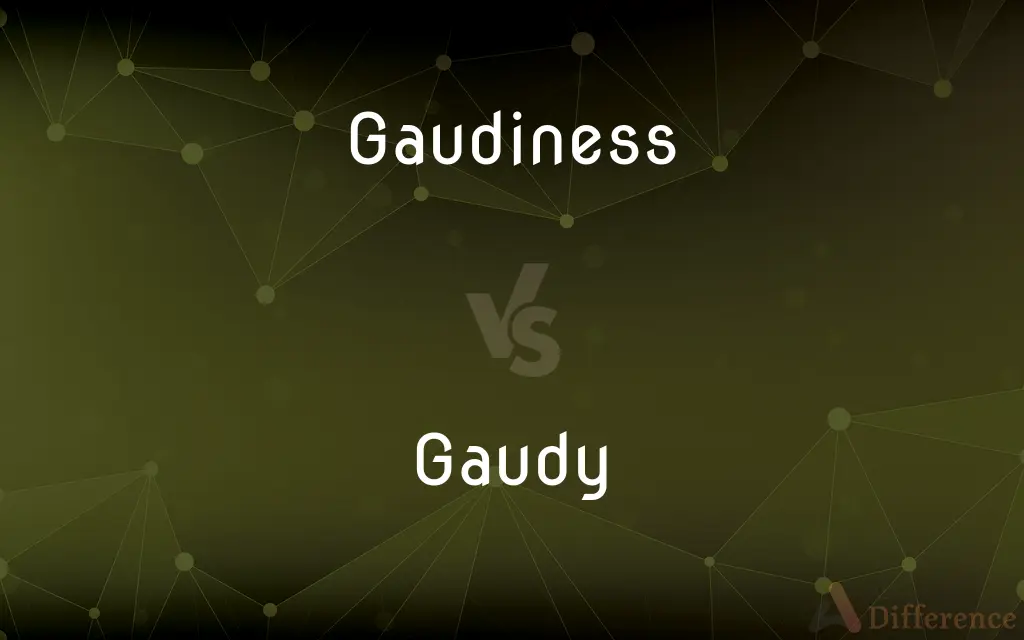Gaudiness vs. Gaudy — What's the Difference?
By Tayyaba Rehman & Urooj Arif — Updated on April 1, 2024
Gaudiness refers to the quality of being excessively bright or showy, often to the point of being tasteless, while gaudy describes an object or style that embodies this ostentatiousness.

Difference Between Gaudiness and Gaudy
Table of Contents
ADVERTISEMENT
Key Differences
Gaudiness is a characteristic attributed to objects, designs, or styles that are excessively showy, bright, or decorated in a manner that lacks sophistication and good taste. This quality often results in a visual overload, where the primary aim seems to be to attract attention through vivid colors and elaborate details. On the other hand, gaudy is an adjective used to describe specific items, outfits, or decorations that exhibit this quality of excessive showiness. It is directly applied to items that visually stand out in a manner that is often considered tasteless or overly extravagant.
While gaudiness conveys a sense of the overall quality or state of being flashy or excessively ornate, suggesting a measure of excess in design or appearance that goes beyond what is considered aesthetically pleasing, gaudy items are tangible examples of this excess. They can range from clothing and jewelry to interior decor, where the emphasis is on the use of bright colors, glitter, and patterns that are densely packed or highly contrasting, resulting in a lack of harmony and balance.
The concept of gaudiness implies a subjective judgment about style and aesthetics, indicating that what might be deemed excessively showy or tasteless by some could be considered attractive or stylish by others. Gaudy, as a descriptive term, highlights the presence of these qualities in specific objects or styles, pointing to a deliberate choice to embrace a bold, attention-grabbing aesthetic.
In the realm of fashion and design, gaudiness can be a deliberate choice, reflecting a preference for styles that break conventional norms and embrace a more is more philosophy. Similarly, choosing gaudy items or decor can be a statement of individuality, signaling a departure from minimalist trends and a penchant for vibrant, eclectic looks.
The perception of gaudiness and the appreciation of gaudy items are significantly influenced by cultural and temporal contexts. What is considered gaudy in one culture or era might be viewed as elegant or fashionable in another, underscoring the subjective nature of these concepts and their dependence on societal norms and trends.
ADVERTISEMENT
Comparison Chart
Definition
The quality of being excessively bright, showy, or elaborately decorated.
An object or style that is excessively bright, showy, or elaborately decorated.
Usage
Describes a characteristic or quality.
Used to describe specific items or styles.
Implication
Implies a judgment about overall aesthetic value or taste.
Directly points to the presence of excessive ornamentation or color.
Context
Can apply to an overall style or design approach.
Applies to individual items or specific design elements.
Perception
Subjective and can vary based on cultural or personal standards.
Often viewed as a tangible representation of tastelessness or extravagance.
Compare with Definitions
Gaudiness
The state of being overly vivid or excessively ornate.
The gaudiness of the costume made it difficult to look away.
Gaudy
Describing an item or style that is excessively bright or showy.
The gaudy necklace was adorned with multiple, brightly colored gems.
Gaudiness
A quality of striking brightness that often lacks aesthetic restraint.
The room's gaudiness was overwhelming, with its bright pink walls and golden decor.
Gaudy
Pertaining to an overly decorated or vivid appearance.
She wore a gaudy dress that sparkled under the party lights.
Gaudiness
The characteristic of lacking subtlety in design or presentation.
The gaudiness of the jewelry collection catered to those preferring more is more.
Gaudy
Characterized by a lack of taste due to excessive ornamentation.
The gaudy wallpaper made the room feel cluttered and chaotic.
Gaudiness
An attribute of being showy or flashy to the point of tastelessness.
The festival is known for its gaudiness, attracting visitors with its colorful and elaborate floats.
Gaudy
Reflecting a bold choice in fashion or decor, often with the aim to stand out.
His gaudy tie choice made him the center of attention at the office.
Gaudiness
A measure of visual excess or flamboyance.
The gaudiness of the decoration was a topic of discussion among the guests.
Gaudy
An example of an object or design that prioritizes attention-grabbing details over harmony.
The gaudy decorations were intended to be eye-catching but ended up overwhelming the space.
Gaudiness
Showy in a tasteless or vulgar way.
Gaudy
Gaudy or gaudie (from the Latin, "gaudium", meaning "enjoyment" or "merry-making") is a term used to reflect student life in a number of the ancient universities in the United Kingdom as well as other institutions such as Durham University and Reading University. It is generally believed to relate to the traditional student song, "De Brevitate Vitae" (On the Shortness of Life), which is commonly known as the Gaudeamus (Let's make merry) by virtue of its first word.
Gaudiness
Pretension in appearance; looking overly and distastefully adorned.
Nearby residents don't want any gaudiness in the building's renovation: they want it to be tasteful and understated.
Gaudy
Extravagantly bright or showy, typically so as to be tasteless
Silver bows and gaudy ribbons
Gaudiness
The quality of being gaudy.
Gaudy
A celebratory dinner or entertainment held by a college for old members
Administratively, the college cannot cope with more than one gaudy per year
Gaudiness
Tasteless showiness
Gaudy
Showy in a tasteless or vulgar way.
Gaudiness
Strident color or excessive ornamentation
Gaudy
A feast, especially an annual university dinner.
Gaudy
Very showy or ornamented, now especially when excessive, or in a tasteless or vulgar manner.
Gaudy
(obsolete) fun; merry; festive.
Gaudy
(archaic) One of the large beads in the rosary at which the paternoster is recited.
Gaudy
(Oxon) A reunion held by one of the colleges of the University of Oxford for alumni, normally held during the long vacation.
Gaudy
Ostentatiously fine; showy; gay, but tawdry or meretricious.
Costly thy habit as thy purse can buy,But not expressed in fancy; rich, not gaudy.
Gaudy
Gay; merry; festal.
Let's have one other gaudy night.
Gaudy
One of the large beads in the rosary at which the paternoster is recited.
Gaudy
A feast or festival; - called also gaud-day and gaudy day.
Gaudy
A celebratory feast held annually at one of the colleges in a British university
Gaudy
Tastelessly showy;
A flash car
A flashy ring
Garish colors
A gaudy costume
Loud sport shirts
A meretricious yet stylish book
Tawdry ornaments
Gaudy
(used especially of clothes) marked by conspicuous display
Common Curiosities
What defines gaudiness?
Gaudiness is defined by an excessive brightness, showiness, or elaborate decoration that often lacks in aesthetic restraint or taste.
What is the difference between gaudiness and elegance?
Gaudiness is associated with excessive ornamentation and lack of restraint, whereas elegance is characterized by simplicity, tastefulness, and subtlety.
How can an object be described as gaudy?
An object is described as gaudy when it is excessively bright, showy, or elaborately decorated in a manner that can be seen as tasteless or overly extravagant.
Is gaudiness always negative?
While often viewed negatively for lacking subtlety, gaudiness can be celebrated in certain contexts or cultures as a form of expressive, bold style.
Are all gaudy items considered cheap?
Not necessarily; gaudy items can be expensive, depending on the materials and craftsmanship, but are distinguished by their elaborate and ostentatious appearance.
Can gaudiness be fashionable?
Yes, gaudiness can be considered fashionable in settings where bold, vivid, and elaborate styles are appreciated or in vogue.
Can a minimalist style be gaudy?
Typically, no. Gaudiness contradicts minimalist principles, which favor simplicity and understatement over excess and elaboration.
How does cultural perception affect gaudiness?
Cultural backgrounds and norms significantly influence what is considered gaudy, with some cultures embracing more vivid and elaborate styles than others.
Can a design be both gaudy and aesthetically pleasing?
Yes, depending on personal taste and cultural standards, a design can be both gaudy and appealing to some individuals.
How does one avoid gaudiness in decor?
To avoid gaudiness, one can focus on balance, restraint in the use of color and ornamentation, and prioritizing harmony over excess.
Can gaudiness be a deliberate design choice?
Yes, designers and individuals may choose gaudiness to make a bold statement or as a reflection of personal or cultural identity.
What makes an outfit gaudy?
An outfit is considered gaudy if it includes excessively bright colors, bold patterns, or elaborate decorations that create a showy appearance.
Share Your Discovery

Previous Comparison
Relay vs. Convey
Next Comparison
Instruction vs. RuleAuthor Spotlight
Written by
Tayyaba RehmanTayyaba Rehman is a distinguished writer, currently serving as a primary contributor to askdifference.com. As a researcher in semantics and etymology, Tayyaba's passion for the complexity of languages and their distinctions has found a perfect home on the platform. Tayyaba delves into the intricacies of language, distinguishing between commonly confused words and phrases, thereby providing clarity for readers worldwide.
Co-written by
Urooj ArifUrooj is a skilled content writer at Ask Difference, known for her exceptional ability to simplify complex topics into engaging and informative content. With a passion for research and a flair for clear, concise writing, she consistently delivers articles that resonate with our diverse audience.
















































